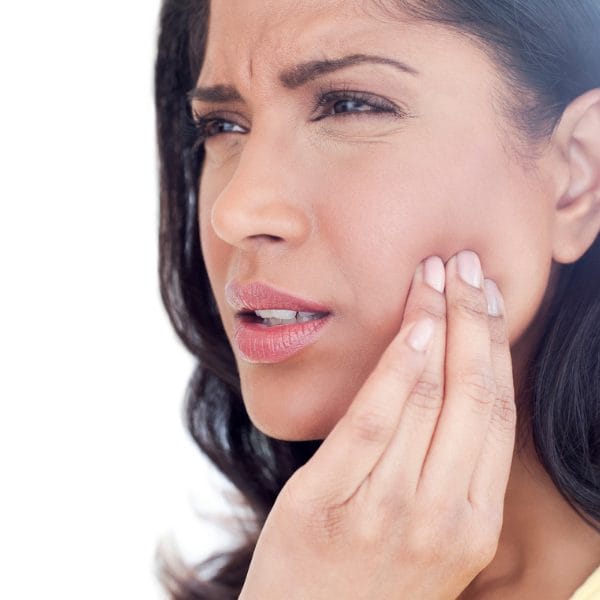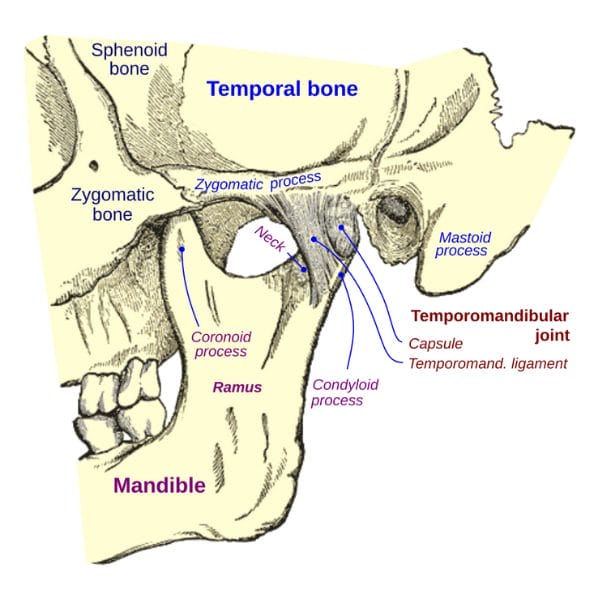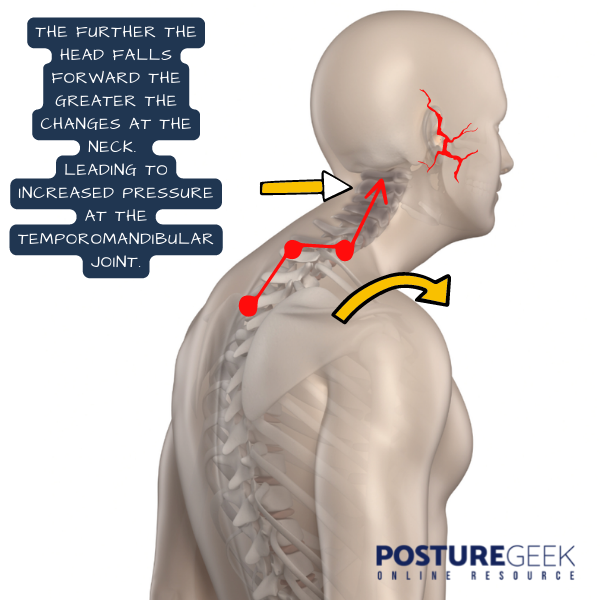Jaw and Neck Pain: What You Should Know

In our fast-paced, constantly-connected world, it’s no wonder that so many people suffer from jaw and neck pain. Our technology has given us the ability to be constantly productive, but at what cost? In this blog post, we’ll explore the causes of jaw and neck pain and offer some solutions.
Temporomandibular Joint (TMJ)

The temporomandibular joint (TMJ) is a small joint located in front of the ear where the skull and lower jaw meet.
The TMJ is a complex joint that allows the lower jaw (mandible) to move. Temporomandibular joints are made up of the following parts:
The Temporal bone
This is the bone that makes up the side of the skull.
The Mandible
This is the lower jawbone.
The Articular Disc
This small, flexible disc absorbs shock and provides cushioning between the temporal bone and mandible.
The Temporomandibular Joint capsule
This thin membrane surrounds the TMJ, providing it with stability.
What are the TMJ's movements?
The primary motion of the TMJ is called protraction, which involves moving the lower jaw forward.
Other movements include:
- Lateral movement (opening and closing the mouth to one side),
- Protrusion/retrusion (pushing or pulling the jaw forward or backward), and
- Elevation/depression (raising or lowering the lower jaw.
What are the causes of TMJ Pain?
There are many potential causes of TMJ pain, including:
Stress and/or anxiety
Stress and anxiety can lead to clenching or grinding the teeth, putting strain on the TMJ and causing pain.
Arthritis
This is a common cause of TMJ pain. Arthritis can cause the joints to become inflamed, resulting in pain and stiffness.
Bruxism
Bruxism is a condition that involves clenching or grinding the teeth. This can put stress on the TMJ and lead to pain.
Dislocation
The TMJ can become dislocated when the jaw is moved out of alignment. This can happen due to trauma or a misalignment of the teeth.
Infection
An infection in the TMJ can cause inflammation and pain.
What are the symptoms of TMJ disorders?
Temporomandibular joint disorder (TMD) is a general term used to describe several conditions that can affect the TMJ.
PostureGeek.com Tweet
Temporomandibular joint disorder (TMD) is a general term used to describe several conditions that can affect the TMJ.
TMD can be caused by bruxism, misalignment of the teeth, or injury to the joint. Several different symptoms can be associated with TMJ disorders. Some of the most common symptoms include:
- Pain in the jaw, face, neck, or shoulders
- Stiffness or limited movement of the jaw
- Clicking, popping, or grating sound when opening or closing the mouth
- Difficulty chewing or pain while chewing
- Swelling on the side of the face
- Headaches and/or migraines,
- Ear pain, a change in hearing sensitivity, and
- Ringing in the ears (tinnitus)
What are some solutions for TMD?
There are many different treatments for TMD, depending on the underlying cause. Treatment may simply involve over-the-counter pain medication or muscle relaxants in some cases. For more severe cases, a dentist may recommend dental appliances or physical therapy to help loosen the muscles and relax the jaw joint. Some people with TMD may also need to undergo orthodontic treatment to realign their teeth and prevent future problems with the TMJ.
If you are experiencing pain or discomfort due to TMD, it is essential to seek medical attention. With the help of a healthcare professional, you can find relief from your symptoms and get back to living a healthy, pain-free life.
How is TMD diagnosed?

TMJ can be diagnosed by a dentist, physician, or other healthcare professional. The healthcare provider will take a medical history and ask about symptoms. They will also perform a physical examination of the head, neck, and jaw. In some cases, imaging tests (such as X-rays or MRI) may be ordered to get a better look at the TMJ.
Is there a link between jaw and neck pain?
The short answer is yes. The jaw joint, or TMJ, is located just in front of the ear and is responsible for the movement of the mandible (lower jaw). The TMJ is a complex joint, and its problems can lead to pain in the neck, face, and even the shoulders.
There is a link between neck and jaw pain, as both are often caused by the same underlying conditions. For example, arthritis in the neck can lead to inflammation and pain in the TMJ. Similarly, bruxism or stress-related teeth clenching can cause both neck and joint pain due to increased tension in these areas.
How does neck position influence jaw and neck pain?

The position of your neck can influence jaw and neck pain in a number of ways. For example, if your head is tilted forward, it can pressure the muscles in your neck and jaw, leading to pain and discomfort. Poor neck posture, usually identified by rounded shoulders and commonly seen in Forward Head Posture, can also cause issues in your jaw. Additionally, if you sleep with your head tilted to one side, it can cause the muscles on that side of your face to become strained and painful.
To avoid neck pain, it is essential to maintain good posture and keep your head aligned with your spine. Additionally, sleeping on your back or with a pillow under your head can help to reduce neck pain. Suppose you are experiencing jaw or neck pain. In that case, it is best to consult with a healthcare professional for diagnosis and treatment. With the proper care and support, you can find relief from your symptoms and restore good function to your body.
Poor Posture Cycle: Jaw and Neck pain
Treating your upper body posture (by addressing poor neck posture) can improve your jaw movement and range of motion. However, with poor posture, it is possible to set up a negative feedback loop in which faulty movement patterns can lead to deeper problems. As a result, you may be putting yourself on a path to recurring disability if you don’t get treatment now.
In addition, without treatment, you risk establishing a cycle in which the jaw dysfunction leads to neck and shoulder problems, further escalating the jaw issues.
Can you improve TMJ by improving neck position?
There is some evidence that improving neck position can help reduce TMD symptoms by alleviating tension in the muscles and relaxing the jaw joint.
Some possible strategies for improving neck position may include:
- Practising good posture,
- Using a supportive pillow while sleeping, and
- Engaging in regular physical activity or exercise.
Additionally, consulting with a healthcare professional can help you identify other strategies that may be effective for improving neck position and reducing your symptoms of TMD. With the proper care and support, it is possible to find relief from your TMJ disorder and restore good function to your jaw joint.
What are the treatments for TMJ disorder?
The treatment for TMJ disorder will vary depending on the underlying cause. Treatment may simply involve over-the-counter pain medication or muscle relaxants in some cases. For more severe cases, a dentist may recommend dental appliances or physical therapy to help loosen the muscles and relax the jaw joint.
Some people with TMD may also need to undergo orthodontic treatment to realign their teeth and prevent future problems with the TMJ. Regardless of the treatment method, it is essential to work closely with a healthcare professional to find relief from your symptoms and restore good function to your jaw joint.
TMJ disorder can be a painful and debilitating condition. Still, with the help of a healthcare professional, you can find relief from your symptoms and get back to living a healthy, pain-free life.
Finally
TMJ disorder can be a painful and debilitating condition. Still, with the help of a healthcare professional, you can find relief from your symptoms and get back to living a healthy, pain-free life. If you are experiencing any of the symptoms listed above, it is essential to seek medical attention to receive a proper diagnosis and treatment. With the right care, you can find relief from your symptoms and restore good function to your jaw joint.
PLEASE NOTE
PostureGeek.com does not provide medical advice. This information is for educational purposes only and is not intended to be a substitute for professional medical attention. The information provided should not replace the advice and expertise of an accredited health care provider. Any inquiry into your care and any potential impact on your health and wellbeing should be directed to your health care provider. All information is for educational purposes only and is not intended to be a substitute for professional medical care or treatment.
